Impact of Land Use and Land Cover Changes on Urban Ecosystem Service Value in Dhaka, Bangladesh
Abstract
:1. Introduction
2. Materials and Methods
2.1. Study Area
2.2. Datasets
2.3. Landsat Image Processing
2.4. Classification of Land Use and Land Cover (LULC)
2.5. Assignment of Ecosystem Services Values (ESV)
2.6. Calculation of Ecosystem Services Values
2.7. Calculating Elasticity of ESV Due to LULC Changes
2.8. Sensitivity Analysis
3. Results
3.1. Land Use Land Cover Change
3.2. Variation in Ecosystem Services Value
3.2.1. Change in Ecosystem Service Value
3.2.2. Estimated Value of Individual Ecosystem Service Function
3.2.3. Impact of LULC Change on ESV
3.2.4. Sensitivity Analysis
4. Discussion
4.1. Land Use Land Cover Change Dynamics
4.2. Assessment of Urban Ecosystem Service Values
4.3. Limitations and Future Scope of the Study
5. Conclusions
Author Contributions
Funding
Institutional Review Board Statement
Informed Consent Statement
Data Availability Statement
Acknowledgments
Conflicts of Interest
References
- Pharo, E.; Daily, G.C. Nature’s Services: Societal Dependence on Natural Ecosystems. Bryology 1998, 101, 475. [Google Scholar] [CrossRef] [Green Version]
- Arico, S.; Reid, W.V.; Mooney, H.A.; Cropper, A.; Capistrano, D.; Carpenter, S.R.; Chopra, K.; Dasgupta, P.; Dietz, T.; Duraiappah, A.K.; et al. Millennium Ecosystem Assessment. Ecosystems and Human Well-Being: Synthesis; Island Press: Washington, DC, USA, 2005. [Google Scholar]
- Costanza, R.; d’Arge, R.; de Groot, R.; Farber, S.; Grasso, M.; Hannon, B.; Limburg, K.; Naeem, S.; O’Neill, R.V.; Paruelo, J.; et al. The Value of the world’s Ecosystem Services and Natural capital. Nature 1997, 387, 253–260. [Google Scholar] [CrossRef]
- De Groot, R.S.; Alkemade, R.; Braat, L.; Hein, L.; Willemen, L. Challenges in integrating the concept of ecosystem services and values in landscape planning, management and decision making. Ecol. Complex. 2010, 7, 260–272. [Google Scholar] [CrossRef]
- Gómez-Baggethun, E.; Gren, Å.; Barton, D.N.; Langemeyer, J.; McPhearson, T.; O’Farrell, P.; Andersson, E.; Hamstead, Z.; Kremer, P. Urban Ecosystem Services. In Urbanization, Biodiversity and Ecosystem Services: Challenges and Opportunities; Springer Science and Business Media LLC: Berlin, Germany, 2013; pp. 175–251. [Google Scholar] [CrossRef] [Green Version]
- Baró, F.; Chaparro, L.; Gómez-Baggethun, E.; Langemeyer, J.; Nowak, D.J.; Terradas, J. Contribution of Ecosystem Services to Air Quality and Climate Change Mitigation Policies: The Case of Urban Forests in Barcelona, Spain. Ambio 2014, 43, 466–479. [Google Scholar] [CrossRef] [PubMed] [Green Version]
- Langemeyer, J.; Gómez-Baggethun, E.; Haase, D.; Scheuer, S.; Elmqvist, T. Bridging the Gap Between Ecosystem Service Assessments and Land-Use Planning through Multi-Criteria Decision Analysis (MCDA). Environ. Sci. Policy 2016, 62, 45–56. [Google Scholar] [CrossRef]
- Haase, D.; Larondelle, N.; Andersson, E.; Artmann, M.; Borgström, S.; Breuste, J.; Gomez-Baggethun, E.; Gren, Å.; Hamstead, Z.; Hansen, R.; et al. A Quantitative Review of Urban Ecosystem Service Assessments: Concepts, Models, and Implementation. Ambio 2014, 43, 413–433. [Google Scholar] [CrossRef] [Green Version]
- Söderman, T.; Kopperoinen, L.; Shemeikka, P.; Yli-Pelkonen, V. Ecosystem Services Criteria for Sustainable Development in Urban regions. J. Environ. Assess. Policy Manag. 2012, 14, 1250008. [Google Scholar] [CrossRef]
- Pan, Y.; Zhang, B.; Wu, Y.; Tian, Y. Sustainability Assessment of Urban Ecological-Economic Systems Based on Emergy Analysis: A Case Study in Simao, China. Ecol. Indic. 2021, 121, 107157. [Google Scholar] [CrossRef]
- Liu, W.; Zhan, J.; Zhao, F.; Yan, H.; Zhang, F.; Wei, X. Impacts of Urbanization-Induced Land-Use Changes on Eco-System Services: A Case Study of the Pearl River Delta Metropolitan Region, China. Ecol. Indic. 2019, 98, 228–238. [Google Scholar] [CrossRef]
- Aldana-Domínguez, J.; Palomo, I.; Angonese, J.G.; Schmitz, C.A.; Montes, C. Assessing the Effects of past and Future Land Cover Changes in Ecosystem Services, Disservices and Biodiversity: A Case Study in Barranquilla Metropolitan Area (BMA), Colombia. Ecosyst. Serv. 2019, 37, 100915. [Google Scholar] [CrossRef]
- Chen, Y.; Lu, H.; Li, J.; Xia, J. Effects of Land Use Cover Change on Carbon Emissions and Ecosystem Services in Chengyu Urban Agglomeration, China. Stoch. Environ. Res. Risk Assess. 2020, 34, 1197–1215. [Google Scholar] [CrossRef]
- Quintas-Soriano, C.; Castro, A.J.; Castro, H.; García-Llorente, M. Impacts of Land Use Change on Ecosystem Services and Implications for Human Well-Being in Spanish drylands. Land Use Policy 2016, 54, 534–548. [Google Scholar] [CrossRef]
- Montoya-Tangarife, C.; De La Barrera, F.; Salazar, A.; Inostroza, L. Monitoring the Effects of Land Cover Change on the Supply of Ecosystem Services in an Urban Region: A Study of Santiago-Valparaíso, Chile. PLoS ONE 2017, 12, e0188117. [Google Scholar] [CrossRef] [PubMed]
- Llambí, L.D.; Becerra, M.T.; Peralvo, M.; Avella, A.; Baruffol, M.; Flores, L.J. Monitoring Biodiversity and Eco-System Services in Colombia’s High Andean Ecosystems: Toward an Integrated Strategy. Mt. Res. Dev. 2019, 39, A8. [Google Scholar]
- Tolessa, T.; Senbeta, F.; Kidane, M. The Impact of Land use/Land Cover Change on Ecosystem Services in the Central Highlands of Ethiopia. Ecosyst. Serv. 2017, 23, 47–54. [Google Scholar] [CrossRef]
- Hasan, S.; Shi, W.; Zhu, X. Impact of Land Use Land Cover Changes on Ecosystem Service Value—A Case Study of Guangdong, Hong Kong, and Macao in South China. PLoS ONE 2020, 15, e0231259. [Google Scholar] [CrossRef] [Green Version]
- Grafius, D.R.; Corstanje, R.; Warren, P.H.; Evans, K.L.; Hancock, S.; Harris, J.A. The Impact of Land use/Land Cover Scale on Modelling Urban Ecosystem services. Landsc. Ecol. 2016, 31, 1509–1522. [Google Scholar] [CrossRef] [Green Version]
- Lambin, E.F.; Meyfroidt, P. Global Land Use Change, Economic Globalization, and the Looming Land Scarcity. Proc. Natl. Acad. Sci. USA 2011, 108, 3465–3472. [Google Scholar] [CrossRef] [Green Version]
- Zhao, Q.; Wen, Z.; Chen, S.; Ding, S.; Zhang, M. Quantifying Land Use/Land Cover and Landscape Pattern Changes and Impacts on Ecosystem Services. Int. J. Environ. Res. Public Health 2019, 17, 126. [Google Scholar] [CrossRef] [Green Version]
- Gong, J.; Li, J.; Yang, J.; Li, S.; Tang, W. Land Use and Land Cover Change in the Qinghai Lake Region of the Tibetan Plateau and Its Impact on Ecosystem Services. Int. J. Environ. Res. Public Health 2017, 14, 818. [Google Scholar] [CrossRef]
- Gu, C.; Zhang, Y.; Liu, L.; Li, L.; Li, S.; Zhang, B.; Cui, B.; Rai, M.K. Qualifying Land Use and Land Cover Dynamics and Their Impacts on Ecosystem Service in Central Hima-Laya Transboundary Landscape Based on Google Earth engine. Land 2021, 10, 173. [Google Scholar] [CrossRef]
- Arunyawat, S.; Shrestha, R.P. Assessing Land Use Change and Its Impact on Ecosystem Services in Northern Thailand. Sustainability 2016, 8, 768. [Google Scholar] [CrossRef] [Green Version]
- Woldeyohannes, A.; Cotter, M.; Biru, W.D.; Kelboro, G. Assessing Changes in Ecosystem Service Values over 1985–2050 in Response to Land Use and Land Cover Dynamics in Abaya-Chamo Basin, Southern Ethiopia. Land 2020, 9, 37. [Google Scholar] [CrossRef] [Green Version]
- Talukdar, S.; Singha, P.; Shahfahad; Mahato, S.; Praveen, B.; Rahman, A. Dynamics of Ecosystem Services (ESs) in Response to Land Use Land Cover (LU/LC) Changes in the Lower Gangetic Plain of India. Ecol. Indic. 2020, 112, 106121. [Google Scholar] [CrossRef]
- Sannigrahi, S.; Zhang, Q.; Joshi, P.; Sutton, P.; Keesstra, S.; Roy, P.; Pilla, F.; Basu, B.; Wang, Y.; Jha, S.; et al. Examining Effects of Climate Change and Land Use Dynamic on Biophysical and Economic Values of Ecosystem Services of a Natural Reserve Region. J. Clean. Prod. 2020, 257, 120424. [Google Scholar] [CrossRef]
- Sharma, R.; Rimal, B.; Baral, H.; Nehren, U.; Paudyal, K.; Sharma, S.; Rijal, S.; Ranpal, S.; Acharya, R.P.; Alenazy, A.A.; et al. Impact of Land Cover Change on Ecosystem Services in a Tropical Forested Landscape. Resources 2019, 8, 18. [Google Scholar] [CrossRef] [Green Version]
- Burke, T.; Whyatt, J.D.; Rowland, C.; Blackburn, G.A.; Abbatt, J. The Influence of Land Cover Data on Farm-Scale Valuations of Natural Capital. Ecosyst. Serv. 2020, 42, 101065. [Google Scholar] [CrossRef]
- Lin, X.; Xu, M.; Cao, C.; Singh, R.P.; Chen, W.; Ju, H. Land-use/Land-Cover Changes and Their Influence on the Eco-System in Chengdu City, China During the Period of 1992–2018. Sustainability 2018, 10, 3580. [Google Scholar] [CrossRef] [Green Version]
- Hein, L.; van Koppen, K.; de Groot, R.S.; van Ierland, E.C. Spatial Scales, Stakeholders and the Valuation of Eco-System services. Ecol. Econ. 2006, 57, 209–228. [Google Scholar] [CrossRef]
- Estoque, R.C.; Murayama, Y. Examining the Potential Impact of Land use/Cover Changes on the Ecosystem Services of Baguio City, the Philippines: A Scenario-Based analysis. Appl. Geogr. 2012, 35, 316–326. [Google Scholar] [CrossRef]
- Mondal, M.S.H. The Implications of Population Growth and Climate Change on Sustainable Development in Bangladesh. Jàmbá J. Disaster Risk Stud. 2019, 11, 1–10. [Google Scholar] [CrossRef] [Green Version]
- Chowdhury, M.N.M.; Hossain, M.M. Population Growth and Economic Development in Bangladesh: Revisited Malthus. Am. Econ. Soc. Rev. 2019, 5, 1–7. [Google Scholar] [CrossRef]
- Dewan, A.; Yamaguchi, Y. Land Use and Land Cover Change in Greater Dhaka, Bangladesh: Using Remote Sensing to Promote Sustainable Urbanization. Appl. Geogr. 2009, 29, 390–401. [Google Scholar] [CrossRef]
- Hassan, M.M.; Southworth, J. Analyzing Land Cover Change and Urban Growth Trajectories of the Mega-Urban Region of Dhaka Using Remotely Sensed Data and an Ensemble Classifier. Sustainability 2017, 10, 10. [Google Scholar] [CrossRef] [Green Version]
- Uddin, M.; Anwar, M.; Rahman, M.; Mobin, M. An Investigation on the Pattern of Land Use Change in Dhaka City Using Remote Sensing and GIS Application. J. Environ. Sci. Nat. Resour. 2015, 7, 105–109. [Google Scholar] [CrossRef]
- Dong, Y.; Ren, Z.; Fu, Y.; Miao, Z.; Yang, R.; Sun, Y.; He, X. Recording Urban Land Dynamic and Its Effects During 2000–2019 at 15-M Resolution by Cloud Compu-Ting With Landsat series. Remote Sens. 2020, 12, 2451. [Google Scholar] [CrossRef]
- Clerici, N.; Cote-Navarro, F.; Escobedo, F.J.; Rubiano, K.; Villegas, J.C. Spatio-temporal and cumulative effects of land use-land cover and climate change on two ecosystem services in the Colombian Andes. Sci. Total Environ. 2019, 685, 1181–1192. [Google Scholar] [CrossRef] [PubMed]
- Zinia, N.J.; McShane, P. Ecosystem Services Management: An Evaluation of Green Adaptations for Urban Devel-Opment in Dhaka, Bangladesh. Landsc. Urban. Plan. 2018, 173, 23–32. [Google Scholar] [CrossRef]
- Nahrin, K. Environmental Area Conservation through Urban Planning: Case Study in Dhaka. J. Prop. Plan. Environ. Law 2019, 12, 55–71. [Google Scholar] [CrossRef]
- Rahman, M.H.; Khan, T.Z.; Raju, R.A.; Huq, M.J. Urban Eco-Sustainability and Disaster Risk Reduction by Implementing Vertical Garden in Dhaka City Eco-System Services and Urban Disaster Risk Management. In Proceedings of the International Conference on Disaster Risk Management, Dhaka, Bangladesh, 12–14 January 2019. [Google Scholar]
- Hoque, M.Z.; Cui, S.; Islam, I.; Xu, L.; Tang, J. Future Impact of Land use/Land Cover Changes on Ecosystem Services in the Lower Meghna River Estuary, Bangladesh. Sustainability 2020, 12, 2112. [Google Scholar] [CrossRef] [Green Version]
- Akber, M.A.; Khan, M.W.R.; Islam, M.A.; Rahman, M.M.; Rahman, M.R. Impact of Land Use Change on Ecosystem Services of Southwest Coastal Bangladesh. J. Land Use Sci. 2018, 13, 238–250. [Google Scholar] [CrossRef]
- Huq, N.; Bruns, A.; Ribbe, L. Interactions between Freshwater Ecosystem Services and Land Cover Changes in Southern Bangladesh: A Perspective from Short-Term (seasonal) and Long-Term (1973–2014) Scale. Sci. Total. Environ. 2019, 650, 132–143. [Google Scholar] [CrossRef]
- Zinia, N.J.; McShane, P. Urban Ecosystems and Ecosystem Services in Megacity Dhaka: Mapping and Inventory Analysis. Urban Ecosyst. 2021, 1–14. [Google Scholar] [CrossRef]
- Ahmed, S.J.; Nahiduzzaman, K.M.; Bramley, G. From a Town to a Megacity: 400 Years of Growth. In Dhaka Megacity; Springer Science and Business Media LLC: Berlin, Germany, 2013; pp. 23–43. [Google Scholar] [CrossRef]
- World Population Review. Dhaka Population 2021 (Demographics, Maps, Graphs). 2021. Available online: https://worldpopulationreview.com/en/world-cities/Dhaka-Population (accessed on 19 May 2021).
- Noorunnahar, M.; Hossain, M. Trend Analysis of Rainfall Data in Divisional Meteorological Stations of Bangladesh. Ann. Bangladesh Agric. 2020, 23, 49–61. [Google Scholar] [CrossRef]
- USGS. Using the USGS Landsat Level-1 Data Product. 2019. Available online: https://www.usgs.gov/core-science-systems/nli/landsat/using-usgs-landsat-level-1-data-product (accessed on 5 May 2021).
- Chavez, P.S. Image-Based Atmospheric Corrections—Revisited and improved. Photogramm. Eng. Remote Sens. 1996, 62, 1025–1035. [Google Scholar]
- López-Serrano, P.M.; Corral-Rivas, J.J.; Díaz-Varela, R.A.; Álvarez-González, J.G.; López-Sánchez, C.A. Evaluation of Radiometric and Atmospheric Correction Algorithms for Aboveground Forest Biomass Estimation Using Landsat 5 TM data. Remote Sens. 2016, 8, 369. [Google Scholar] [CrossRef] [Green Version]
- Mahiny, A.S.; Turner, B.J. A Comparison of Four Common Atmospheric Correction Methods. Photogramm. Eng. Remote Sens. 2007, 73, 361–368. [Google Scholar] [CrossRef]
- R Core Team. R: A Language and Environment for Statistical Computing; R Foundation for Statistical Computing: Vienna, Austria, 2019. [Google Scholar]
- Papa, J.P.; Papa, L.P.; Pereira, D.R.; Pisani, R.J. A Hyperheuristic Approach for Unsupervised Land-Cover Classification. IEEE J. Sel. Top. Appl. Earth Obs. Remote Sens. 2016, 9, 2333–2342. [Google Scholar] [CrossRef]
- Brendel, A.S.; Ferrelli, F.; Piccolo, M.C.; Perillo, G.M.E. Assessment of the Effectiveness of Supervised and Unsupervised Methods: Maximizing Land-Cover Classification Accuracy with Spectral Indices Data. J. Appl. Remote Sens. 2019, 13, 014503. [Google Scholar] [CrossRef]
- Papa, J.; Papa, L.; Pisani, R.; Pereira, D. Unsupervised Land-Cover Classification through Hyper-Heuristic-Based Harmony Search. In Proceedings of the 2015 IEEE International Geoscience and Remote Sensing Symposium (IGARSS), IEEE, Milan, Italy, 26–31 July 2015; pp. 69–72. [Google Scholar] [CrossRef]
- Aswatha, S.M.; Mukherjee, J.; Biswas, P.K.; Aikat, S. Unsupervised Classification of Land Cover Using Multi-Modal Data from Multi-Spectral and Hybrid-Polarimetric SAR imageries. Int. J. Remote Sens. 2020, 41, 5277–5304. [Google Scholar] [CrossRef]
- Chatterjee, A.; Saha, J.; Mukherjee, J.; Aikat, S.; Misra, A. Unsupervised Land Cover Classification of Hybrid and Dual-Polarized Images Using Deep Convolutional Neural Network. IEEE Geosci. Remote Sens. Lett. 2021, 18, 969–973. [Google Scholar] [CrossRef]
- Chen, Q.; Kuang, G.; Li, J.; Sui, L.; Li, D. Unsupervised Land Cover/Land Use Classification Using PolSAR Imagery Based on Scattering Similarity. IEEE Trans. Geosci. Remote Sens. 2012, 51, 1817–1825. [Google Scholar] [CrossRef]
- Oyekola, M.A.; Adewuyi, G.K. Unsupervised Classification in Land Cover Types Using Remote Sensing and GIS Techniques. Int. J. Sci. Eng. Investig. 2018, 7, 11–18. [Google Scholar]
- Sinaga, K.P.; Yang, M.-S. Unsupervised K-Means Clustering Algorithm. IEEE Access 2020, 8, 80716–80727. [Google Scholar] [CrossRef]
- Dhanachandra, N.; Manglem, K.; Chanu, Y.J. Image Segmentation Using K -Means Clustering Algorithm and Subtractive Clustering Algorithm. Procedia Comput. Sci. 2015, 54, 764–771. [Google Scholar] [CrossRef] [Green Version]
- Congalton, R.G.; Green, K. Assessing the Accuracy of Remotely Sensed Data Principles and Practices, 3rd ed.; CRC Press Taylor Fr. Group: Boca Raton, FL, USA; London, UK, 2019. [Google Scholar] [CrossRef]
- Hao, F.; Lai, X.; Ouyang, W.; Xu, Y.; Wei, O.; Song, K. Effects of Land Use Changes on the Ecosystem Service Values of a Reclamation Farm in Northeast China. Environ. Manag. 2012, 50, 888–899. [Google Scholar] [CrossRef]
- Ongsomwang, S.; Pattanakiat, S.; Srisuwan, A. Impact of Land Use and Land Cover Change on Ecosystem Service Values: A Case Study of Khon Kaen City, Thailand. Environ. Nat. Resour. J. 2019, 17, 43–58. [Google Scholar] [CrossRef] [Green Version]
- Pullanikkatil, D.; Palamuleni, L.G.; Ruhiiga, T.M. Land use/Land Cover Change and Implications for Ecosystems Services in the Likangala River Catchment, Malawi. Phys. Chem. Earth Parts A/B/C 2016, 93, 96–103. [Google Scholar] [CrossRef]
- Hu, H.; Liu, W.; Cao, M. Impact of Land Use and Land Cover Changes on Ecosystem Services in Menglun, Xishuangbanna, Southwest China. Environ. Monit. Assess. 2007, 146, 147–156. [Google Scholar] [CrossRef] [PubMed]
- Li, R.-Q.; Dong, M.; Cui, J.-Y.; Zhang, L.-L.; Cui, Q.-G.; He, W.-M. Quantification of the Impact of Land-Use Changes on Ecosystem Services: A Case Study in Pingbian County, China. Environ. Monit. Assess. 2007, 128, 503–510. [Google Scholar] [CrossRef] [PubMed]
- Kreuter, U.P.; Harris, H.G.; Matlock, M.D.; Lacey, R. Change in Ecosystem Service Values in the San Antonio Area, Texas. Ecol. Econ. 2001, 39, 333–346. [Google Scholar] [CrossRef]
- Wang, Z.; Cao, J.; Zhu, C.; Yang, H. The Impact of Land Use Change on Ecosystem Service Value in the Upstream of Xiong’an New Area. Sustainability 2020, 12, 5707. [Google Scholar] [CrossRef]
- Yuan, K.; Li, F.; Yang, H.; Wang, Y. The Influence of Land Use Change on Ecosystem Service Value in Shangzhou District. Int. J. Environ. Res. Public Health 2019, 16, 1321. [Google Scholar] [CrossRef] [Green Version]
- Chuai, X.; Huang, X.; Wu, C.; Li, J.; Lu, Q.; Qi, X.; Zhang, M.; Zuo, T.; Lu, J. Land Use and Ecosystems Services Value Changes and Ecological Land Management in Coastal Jiangsu, China. Habitat Int. 2016, 57, 164–174. [Google Scholar] [CrossRef]
- Gashaw, T.; Tulu, T.; Argaw, M.; Worqlul, A.W.; Tolessa, T.; Kindu, M. Estimating the Impacts of Land use/Land Cover Changes on Ecosystem Service Values: The Case of the Andassa Watershed in the Upper Blue Nile Basin of Ethiopia. Ecosyst. Serv. 2018, 31, 219–228. [Google Scholar] [CrossRef]
- Ahmed, B.; Kamruzzaman; Zhu, X.; Rahman, S.; Choi, K. Simulating Land Cover Changes and Their Impacts on Land Surface Temperature in Dhaka, Bangladesh. Remote Sens. 2013, 5, 5969–5998. [Google Scholar] [CrossRef] [Green Version]
- Ibrahim, G.R.F. Urban Land Use Land Cover Changes and Their Effect on Land Surface Temperature: Case Study Using Dohuk City in the Kurdistan Region of Iraq. Climate 2017, 5, 13. [Google Scholar] [CrossRef] [Green Version]
- Wu, Y.; Li, S.; Yu, S. Monitoring Urban Expansion and Its Effects on Land Use and Land Cover Changes in Guang-Zhou City, China. Environ. Monit. Assess. 2016, 188, 54. [Google Scholar] [CrossRef] [PubMed]
- Rahman, M.M.; Hassan, S.; Bahauddin, K.; Ratul, A.K.; Hossain Bhuiyan, A.M. Exploring the Impact of rural–urban Migration on Urban Land Use and Land Cover: A Case of Dhaka City, Bangladesh. Migr. Dev. 2018, 7, 222–239. [Google Scholar] [CrossRef]
- Hossain, S. Migration, Urbanization and Poverty in Dhaka, Bangladesh. J. Asiat. Soc. Bangladesh 2013, 58, 369–382. [Google Scholar]
- Moniruzzaman; Thakur, P.; Kumar, P.; Alam, A.; Garg, V.; Rousta, I.; Olafsson, H. Decadal Urban Land Use/Land Cover Changes and Its Impact on Surface Runoff Potential for the Dhaka City and Surroundings Using Remote Sensing. Remote Sens. 2020, 13, 83. [Google Scholar] [CrossRef]
- Mao, D.; He, X.; Wang, Z.; Tian, Y.; Xiang, H.; Yu, H.; Man, W.; Jia, M.; Ren, C.; Zheng, H. Diverse Policies Leading to Contrasting Impacts on Land Cover and Ecosystem Services in Northeast China. J. Clean. Prod. 2019, 240. [Google Scholar] [CrossRef]
- Zhang, Y.; Zhao, L.; Liu, J.; Liu, Y.; Li, C. The Impact of Land Cover Change on Ecosystem Service Values in Urban Agglomerations Along the Coast of the Bohai Rim, China. Sustainability 2015, 7, 10365–10387. [Google Scholar] [CrossRef] [Green Version]
- Kaiser, G.; Burkhard, B.; Romer, H.; Sangkaew, S.; Graterol, R.; Haitook, T.; Sterr, H.; Sakuna-Schwartz, D. Mapping Tsunami Impacts on Land Cover and Related Ecosystem Service Supply in Phang Nga, Thailand. Nat. Hazards Earth Syst. Sci. 2013, 13, 3095–3111. [Google Scholar] [CrossRef] [Green Version]
- Wang, Z.; Zhang, B.; Zhang, S.; Li, X.; Liu, D.; Song, K.; Li, J.; Li, F.; Duan, H. Changes of Land Use and of Ecosystem Service Values in Sanjiang Plain, Northeast China. Environ. Monit. Assess. 2006, 112, 69–91. [Google Scholar] [CrossRef] [PubMed]
- Mishra, P.K.; Rai, A.; Rai, S.C. Land Use and Land Cover Change Detection Using Geospatial Techniques in the Sikkim Himalaya, India. Egypt. J. Remote. Sens. Space Sci. 2020, 23, 133–143. [Google Scholar] [CrossRef]
- Guo, L.; Xi, X.; Yang, W.; Liang, L. Monitoring Land Use/Cover Change Using Remotely Sensed Data in Guangzhou of China. Sustainability 2021, 13, 2944. [Google Scholar] [CrossRef]
- Collins, W.H.; Elekwachi, W. Geo-Spatial Analysis of Urban Wetlands Loss in Obio/Akpor Local Government Area of Rivers State, Nigeria. Asian J. Geogr. Res. 2020. [CrossRef] [Green Version]
- Wang, Y.; Zhang, X.; Peng, P. Spatio-Temporal Changes of Land-use/Land Cover Change and the Effects on Ecosystem Service Values in Derong County, China, from 1992–2018. Sustainability 2021, 13, 827. [Google Scholar] [CrossRef]
- Xie, G.D.; Zhen, L.; Lu, C.-x.; Xiao, Y.; Chen, C. Expert Knowledge Based Valuation Method of Ecosystem Services in China. J. Environ. Manag. 2018, 23, 911–919. [Google Scholar]
- Song, W.; Deng, X. Land-use/Land-Cover Change and Ecosystem Service Provision in China. Sci. Total. Environ. 2017, 576, 705–719. [Google Scholar] [CrossRef] [PubMed]
- Aschonitis, V.G.; Gaglio, M.; Castaldelli, G.; Fano, E.A. Criticism on Elasticity-Sensitivity Coefficient for Assessing the Robustness and Sensitivity of Ecosystem Services values. Ecosyst. Serv. 2016, 20, 66–68. [Google Scholar] [CrossRef]
- Zank, B.; Bagstad, K.J.; Voigt, B.; Villa, F. Modeling the Effects of Urban Expansion on Natural Capital Stocks and Ecosystem Service Flows: A Case Study in the Puget Sound, Washington, USA. Landsc. Urban. Plan. 2016, 149, 31–42. [Google Scholar] [CrossRef]
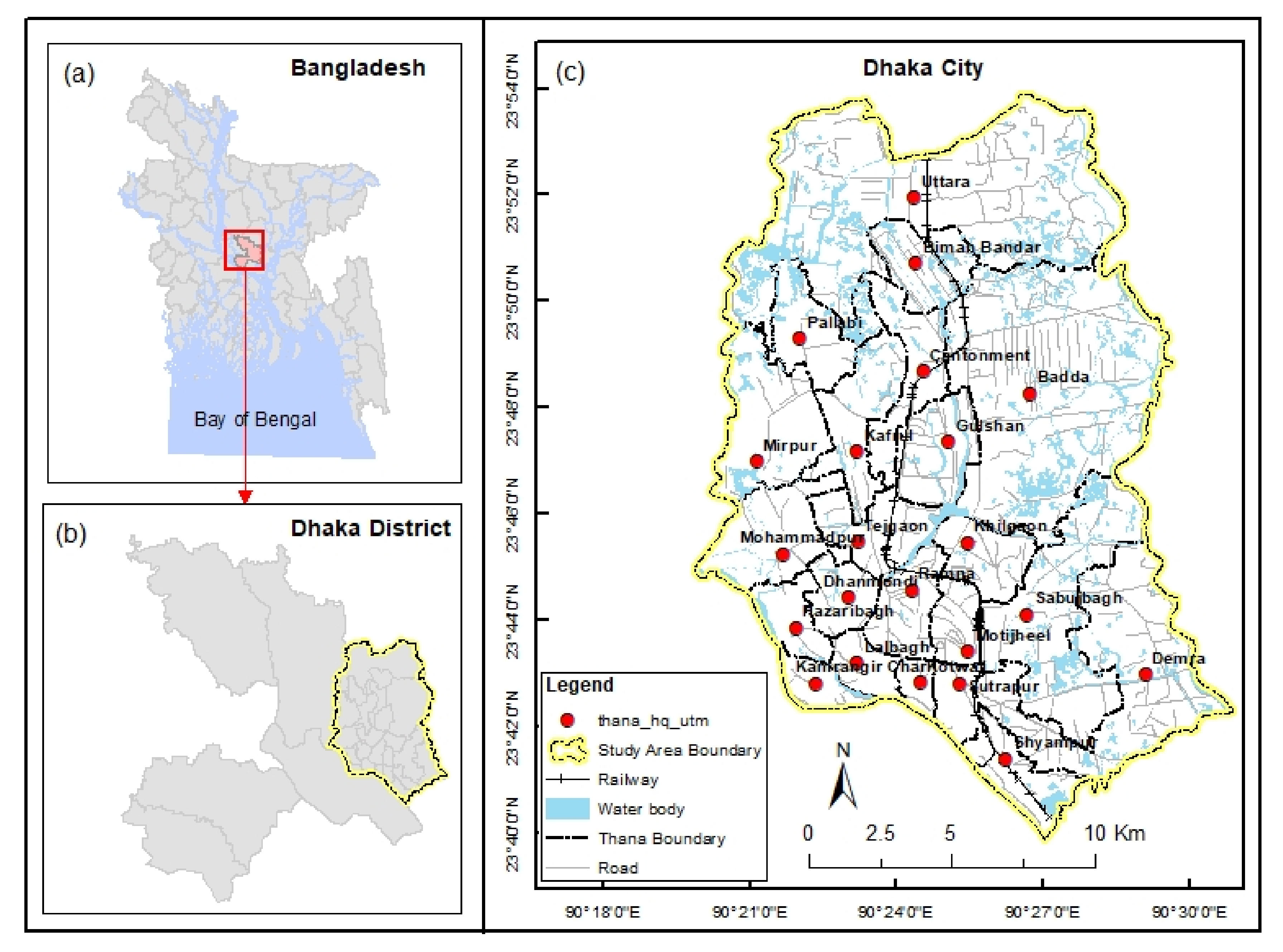
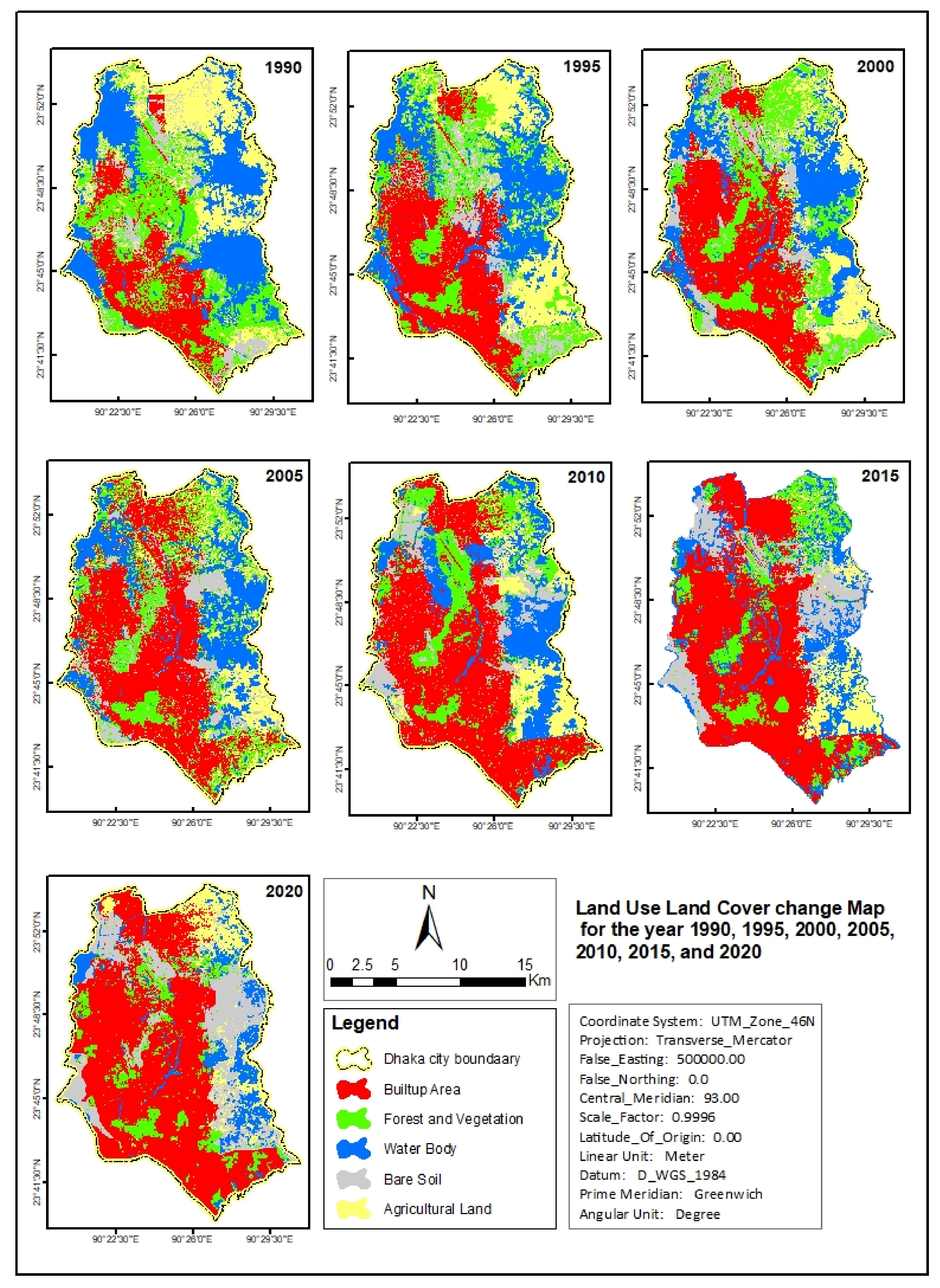
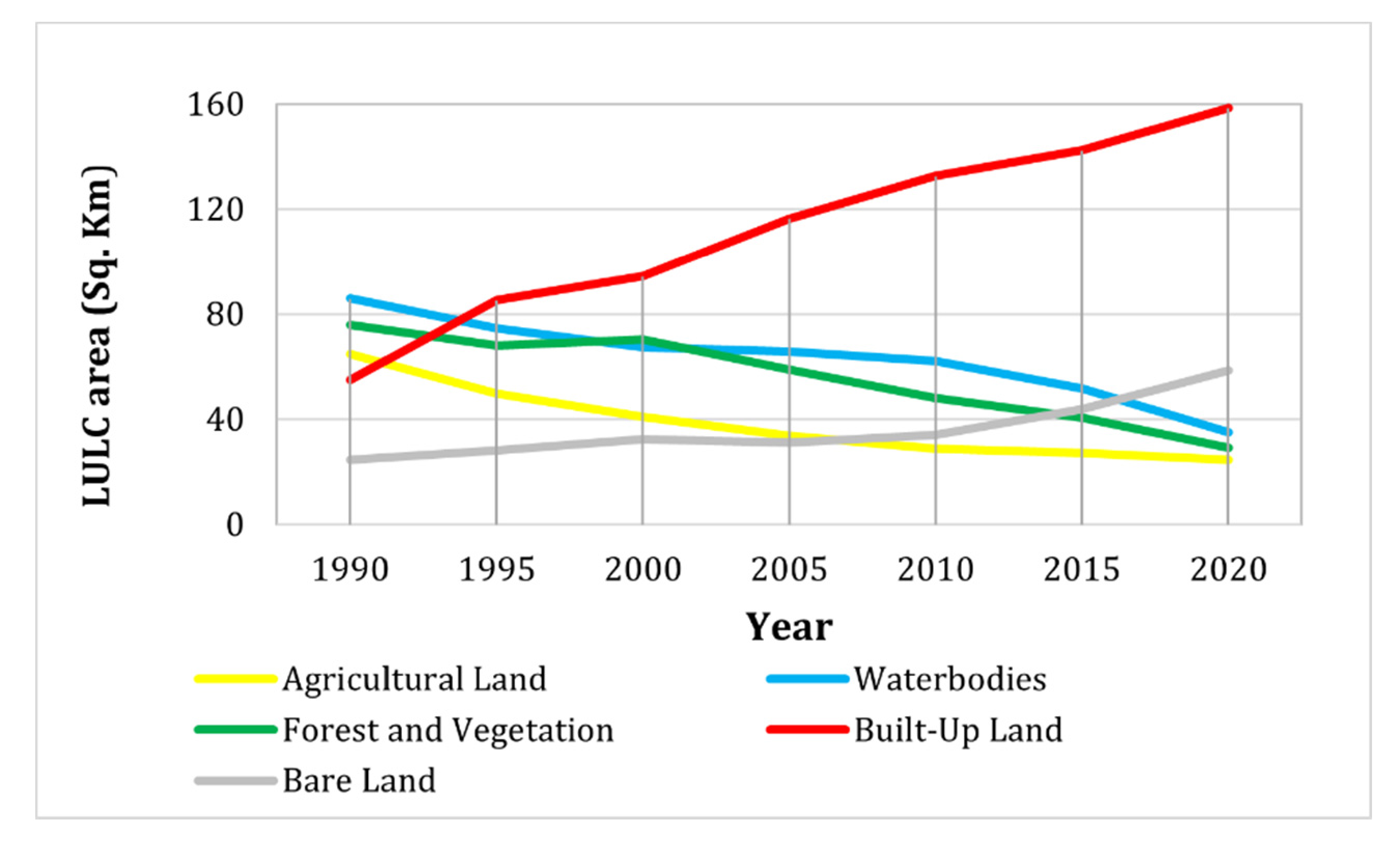

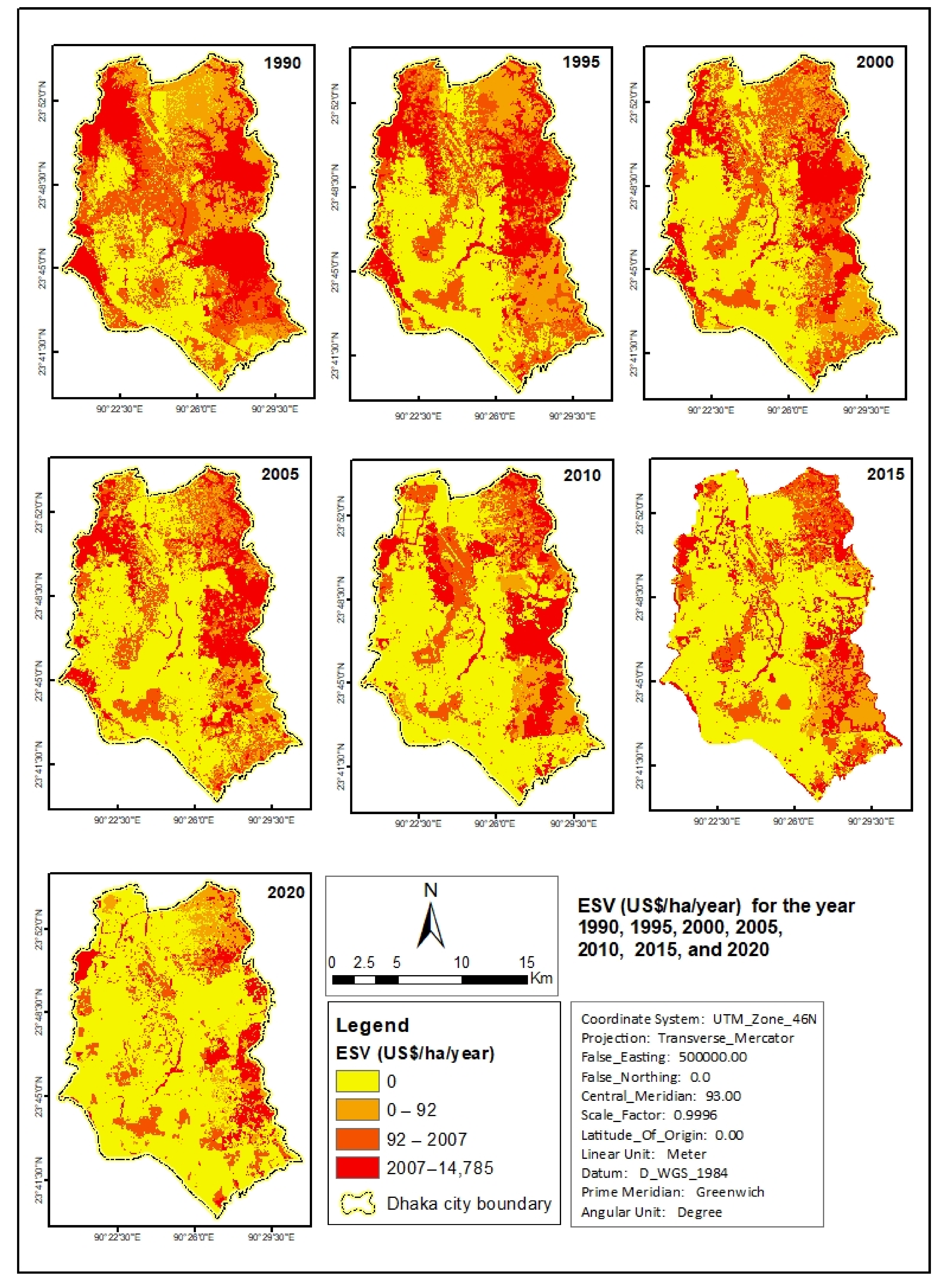
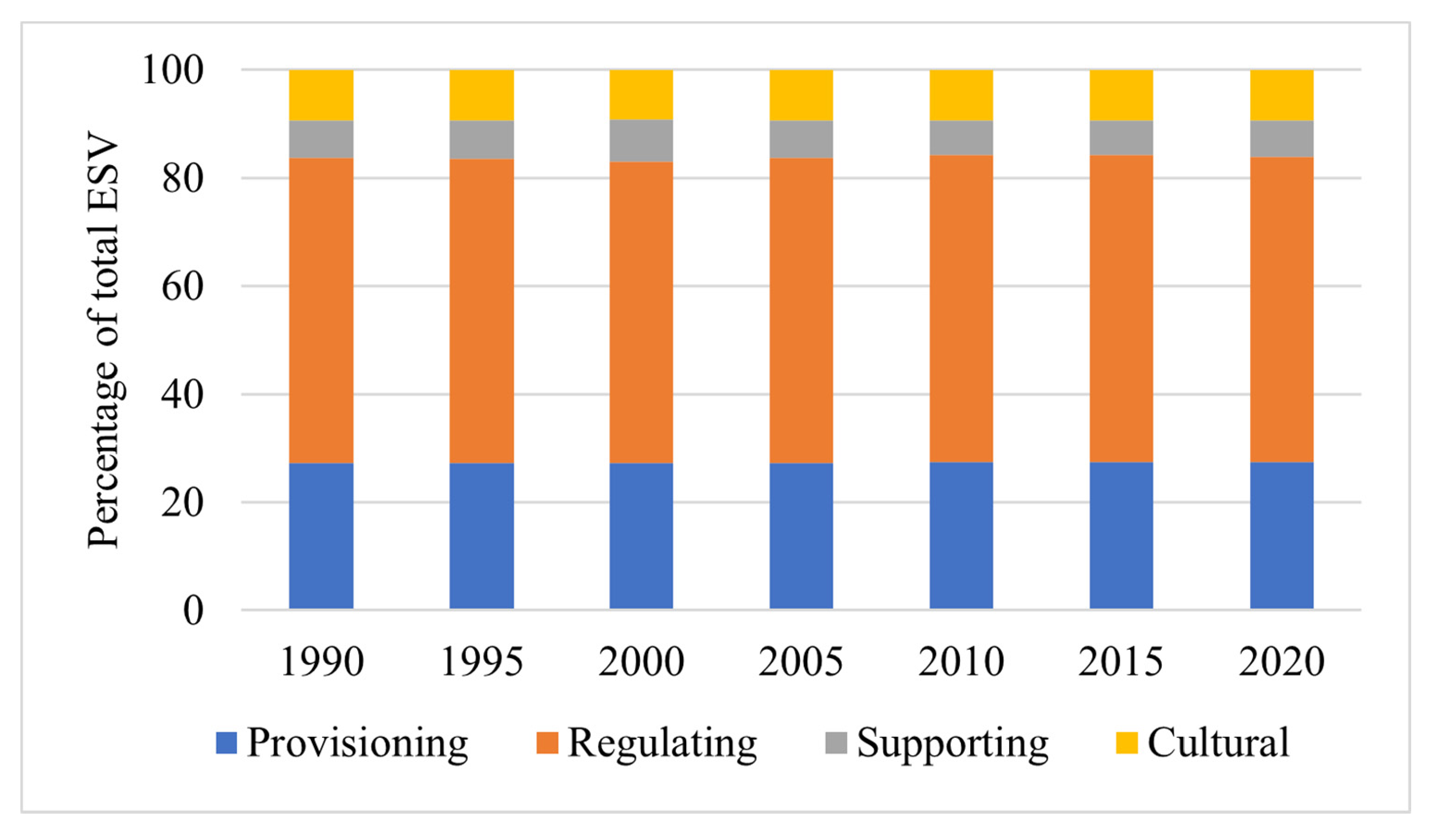
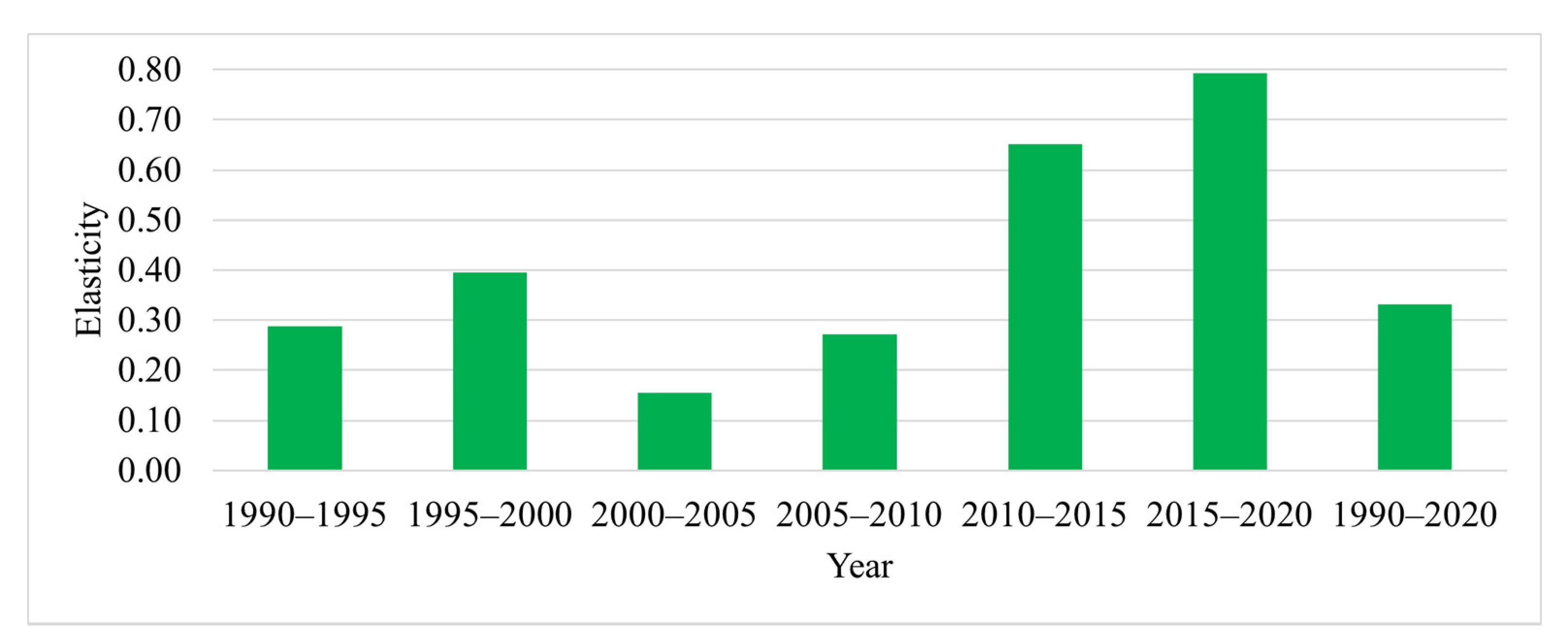

| Landsat Scene ID | Acquisition Date | Time (GMT) | Satellite | Sensor | Path/Row | Resolution |
|---|---|---|---|---|---|---|
| LT51370441990343BKT00 | 9 December 1990 | 03:44:06.95 | Landsat 5 | TM | 137/44 | 30 |
| LT51370441995325BKT00 | 21 November 1995 | 03:24:28.03 | Landsat 5 | TM | 137/44 | 30 |
| LE71370442000331SGS00 | 26 November 2000 | 04:15:10.40 | Landsat 7 | ETM+ | 137/44 | 30 |
| LT51370442005320BKT01 | 16 November 2005 | 04:13:15.00 | Landsat 5 | TM | 137/44 | 30 |
| LT51370442010318KHC00 | 14 November 2010 | 04:14:36.41 | Landsat 5 | TM | 137/44 | 30 |
| LC81370442015316LGN02 | 12 November 2015 | 04:24:55.23 | Landsat 8 | OLI | 137/44 | 30 |
| LC81370442020330LGN00 | 25 November 2020 | 04:25:09.27 | Landsat 8 | OLI | 137/44 | 30 |
| Land Cover Type | Description |
|---|---|
| Built–up Area | Urban area, residential, commercial, industrial areas, mixed-use, settlements, transport, and other man-made structures |
| Waterbody | River, lake, pond, canal, low land, wetland, etc. |
| Vegetation | Trees, mixed forest, natural vegetation, gardens, parks, playground, etc. |
| Bare Land | Open space, construction site, Fallow land, land surface without vegetation, Sand, transitional areas, bare soil, etc. |
| Agricultural Land | Cropland and pasture, orchards, groves, nurseries, and other agricultural lands. |
| LULC Types | Equivalent Biome | Ecosystem Service Value Coefficient |
|---|---|---|
| Agricultural land | Cropland | 92 |
| Water body | Wetland | 14,785 |
| Forest and vegetation | Tropical forest | 2007 |
| Built-up area | Urban | 0 |
| Bare land | Desert | 0 |
| Land Cover Class/Year | Agricultural Land | Waterbodies | Forest and Vegetation | Built-Up Land | Bare Land | |
|---|---|---|---|---|---|---|
| 1990 | Area | 64.66 | 85.85 | 75.74 | 54.96 | 24.52 |
| % | 21.15 | 28.08 | 24.77 | 17.98 | 8.02 | |
| 1995 | Area | 49.59 | 74.65 | 68.01 | 85.21 | 28.15 |
| % | 16.23 | 24.43 | 22.25 | 27.88 | 9.21 | |
| 2000 | Area | 40.85 | 67.43 | 70.33 | 94.48 | 32.54 |
| % | 13.37 | 22.06 | 23.01 | 30.91 | 10.65 | |
| 2005 | Area | 33.72 | 65.62 | 58.77 | 116.43 | 31.11 |
| % | 11.03 | 21.47 | 19.23 | 38.09 | 10.18 | |
| 2010 | Area | 28.86 | 62.07 | 48.00 | 132.58 | 34.12 |
| % | 9.44 | 20.31 | 15.71 | 43.38 | 11.16 | |
| 2015 | Area | 27.32 | 51.71 | 40.56 | 142.39 | 43.74 |
| % | 8.94 | 16.91 | 13.27 | 46.57 | 14.31 | |
| 2020 | Area | 24.70 | 34.94 | 29.11 | 158.49 | 58.42 |
| % | 8.08 | 11.43 | 9.52 | 51.85 | 19.11 | |
| Land Cover Class | 1990–1995 | 1995–2000 | 2000–2005 | 2005–2010 | 2010–2015 | 2015–2020 | 1990–2020 |
|---|---|---|---|---|---|---|---|
| Agricultural Land | −4.66 | −3.52 | −3.49 | −2.88 | −1.07 | −1.92 | −2.06 |
| Waterbodies | −2.61 | −1.93 | −0.54 | −1.08 | −3.34 | −6.49 | −1.98 |
| Forest and Vegetation | −2.04 | 0.68 | −3.29 | −3.66 | −3.10 | −5.65 | −2.05 |
| Built-Up Land | 11.01 | 2.18 | 4.64 | 2.77 | 1.48 | 2.26 | 6.28 |
| Bare Land | 2.96 | 3.12 | −0.88 | 1.94 | 5.64 | 6.71 | 4.61 |
| LULC Type | LULC Allocation in 2020 (%) | ||||||
|---|---|---|---|---|---|---|---|
| Agricultural Land | Waterbodies | Forest and Vegetation | Built-Up Land | Bare Land | Grand Total | ||
| LULC allocation in 1990 (%) | Agricultural Land | 4.23 | 2.54 | 1.79 | 9.18 | 3.38 | 21.15 |
| Waterbodies | 2.78 | 6.91 | 1.40 | 5.46 | 11.52 | 28.08 | |
| Forest and Vegetation | 0.60 | 1.60 | 4.22 | 15.58 | 2.79 | 24.77 | |
| Built-Up Land | 0.05 | 0.07 | 1.32 | 16.27 | 0.29 | 17.98 | |
| Bare Land | 0.42 | 0.27 | 0.81 | 5.39 | 1.13 | 8.02 | |
| Grand Total | 8.08 | 11.43 | 9.52 | 51.85 | 19.11 | 100.00 | |
| LULC/Year | Agricultural Land | Water Body | Forest and Vegetation | Built-up Area | Bare Land | Total ESV | |
|---|---|---|---|---|---|---|---|
| 1990 | ESV | 0.59 | 126.93 | 15.20 | 0.00 | 0.00 | 142.72 |
| % | 0.42 | 88.93 | 10.65 | 0.00 | 0.00 | 100.00 | |
| 1995 | ESV | 0.46 | 110.37 | 13.65 | 0.00 | 0.00 | 124.47 |
| % | 0.37 | 88.67 | 10.97 | 0.00 | 0.00 | 100.00 | |
| 2000 | ESV | 0.38 | 99.69 | 14.12 | 0.00 | 0.00 | 114.18 |
| % | 0.33 | 87.31 | 12.36 | 0.00 | 0.00 | 100.00 | |
| 2005 | ESV | 0.31 | 97.02 | 11.79 | 0.00 | 0.00 | 109.12 |
| % | 0.28 | 88.91 | 10.81 | 0.00 | 0.00 | 100.00 | |
| 2010 | ESV | 0.27 | 91.77 | 9.63 | 0.00 | 0.00 | 101.67 |
| % | 0.26 | 90.26 | 9.48 | 0.00 | 0.00 | 100.00 | |
| 2015 | ESV | 0.25 | 76.45 | 8.14 | 0.00 | 0.00 | 84.84 |
| % | 0.30 | 90.11 | 9.60 | 0.00 | 0.00 | 100.00 | |
| 2020 | ESV | 0.23 | 51.65 | 5.84 | 0.00 | 0.00 | 57.72 |
| % | 0.39 | 89.49 | 10.12 | 0.00 | 0.00 | 100.00 | |
| Land Cover Class | |||||||
|---|---|---|---|---|---|---|---|
| 1990–1995 | 1995–2000 | 2000–2005 | 2005–2010 | 2010–2015 | 2015–2020 | 1990–2020 | |
| Agricultural Land | −4.66 | −3.52 | −3.49 | −2.88 | −1.07 | −1.92 | −2.06 |
| Waterbodies | −2.61 | −1.93 | −0.54 | −1.08 | −3.34 | −6.49 | −1.98 |
| Forest and Vegetation | −2.04 | 0.68 | −3.29 | −3.66 | −3.10 | −5.65 | −2.05 |
| Built-up area | 0 | 0 | 0 | 0 | 0 | 0 | 0 |
| Bare Land | 0 | 0 | 0 | 0 | 0 | 0 | 0 |
| Total ESV change | −2.56 | −1.65 | −0.89 | −1.37 | −3.31 | −6.39 | −1.99 |
| Individual ESV Function | 1990 | 1995 | 2000 | 2005 | 2010 | 2015 | 2020 | ||||||||
|---|---|---|---|---|---|---|---|---|---|---|---|---|---|---|---|
| ESVf | % | ESVf | % | ESVf | % | ESVf | % | ESVf | % | ESVf | % | ESVf | % | ||
| Provisioning | Food production | 2.79 | 1.95 | 2.4 | 1.93 | 2.17 | 1.9 | 2.05 | 1.88 | 1.9 | 1.87 | 1.6 | 1.89 | 1.12 | 1.94 |
| Water supply | 32.7 | 22.9 | 28.4 | 22.8 | 25.7 | 22.5 | 25 | 22.9 | 23.6 | 23.2 | 19.7 | 23.2 | 13.3 | 23 | |
| Raw material | 3.3 | 2.31 | 2.93 | 2.36 | 2.93 | 2.57 | 2.55 | 2.33 | 2.17 | 2.13 | 1.83 | 2.15 | 1.29 | 2.23 | |
| Genetic resources | 0.31 | 0.22 | 0.28 | 0.22 | 0.29 | 0.25 | 0.24 | 0.22 | 0.2 | 0.19 | 0.17 | 0.2 | 0.12 | 0.21 | |
| Regulating | Water regulation | 0.17 | 0.12 | 0.15 | 0.12 | 0.14 | 0.13 | 0.13 | 0.12 | 0.12 | 0.12 | 0.1 | 0.12 | 0.07 | 0.12 |
| Waste treatment | 36.5 | 25.6 | 31.8 | 25.5 | 28.8 | 25.2 | 27.9 | 25.6 | 26.3 | 25.9 | 22 | 25.9 | 14.8 | 25.7 | |
| Erosion control | 1.86 | 1.3 | 1.67 | 1.34 | 1.72 | 1.51 | 1.44 | 1.32 | 1.18 | 1.16 | 0.99 | 1.17 | 0.71 | 1.24 | |
| Climate regulation | 1.69 | 1.18 | 1.52 | 1.22 | 1.57 | 1.37 | 1.31 | 1.2 | 1.07 | 1.05 | 0.9 | 1.07 | 0.65 | 1.12 | |
| Biological control | 0.16 | 0.11 | 0.12 | 0.1 | 0.1 | 0.09 | 0.08 | 0.07 | 0.07 | 0.07 | 0.07 | 0.08 | 0.06 | 0.1 | |
| Gas regulation | 1.14 | 0.8 | 0.99 | 0.8 | 0.9 | 0.79 | 0.87 | 0.8 | 0.83 | 0.81 | 0.69 | 0.81 | 0.46 | 0.8 | |
| Disturbance regulation | 39 | 27.3 | 33.9 | 27.2 | 30.6 | 26.8 | 29.8 | 27.3 | 28.2 | 27.7 | 23.5 | 27.7 | 15.9 | 27.5 | |
| Supporting | Nutrient cycling | 6.98 | 4.89 | 6.27 | 5.04 | 6.48 | 5.68 | 5.42 | 4.97 | 4.43 | 4.35 | 3.74 | 4.41 | 2.68 | 4.65 |
| Pollination | 0.09 | 0.06 | 0.07 | 0.06 | 0.06 | 0.05 | 0.05 | 0.04 | 0.04 | 0.04 | 0.04 | 0.05 | 0.03 | 0.06 | |
| Soil formation | 0.08 | 0.05 | 0.07 | 0.05 | 0.07 | 0.06 | 0.06 | 0.05 | 0.05 | 0.05 | 0.04 | 0.05 | 0.03 | 0.05 | |
| Habitat/refugia | 2.61 | 1.83 | 2.27 | 1.82 | 2.05 | 1.8 | 1.99 | 1.83 | 1.89 | 1.86 | 1.57 | 1.85 | 1.06 | 1.84 | |
| Cultural | Recreation | 5.78 | 4.05 | 5.05 | 4.05 | 4.66 | 4.08 | 4.42 | 4.05 | 4.1 | 4.03 | 3.42 | 4.03 | 2.33 | 4.04 |
| Cultural | 7.58 | 5.31 | 6.59 | 5.29 | 5.95 | 5.21 | 5.79 | 5.31 | 5.48 | 5.39 | 4.56 | 5.38 | 3.08 | 5.34 | |
| Total | 142.72 | 100 | 124.47 | 100 | 114.18 | 100 | 109.12 | 100 | 102.67 | 100 | 84.84 | 100 | 57.72 | 100 | |
| Ecosystem Service Function | 1990–1995 | 1995–2000 | 2005–2010 | 2010–2015 | 2015–2020 | 1990–2020 | |
|---|---|---|---|---|---|---|---|
| Provisioning | Food production | −0.39 | −0.22 | −0.12 | −0.3 | −0.48 | −1.67 |
| Water supply | −4.26 | −2.74 | −0.7 | −3.94 | −6.38 | −19.38 | |
| Raw material | −0.36 | 0 | −0.38 | −0.34 | −0.54 | −2.01 | |
| Genetic resources | −0.03 | 0.01 | −0.05 | −0.03 | −0.05 | −0.19 | |
| Regulating | Water regulation | −0.02 | −0.01 | −0.01 | −0.02 | −0.03 | −0.1 |
| Waste treatment | −4.75 | −3 | −0.86 | −4.39 | −7.1 | −21.67 | |
| Erosion control | −0.19 | 0.06 | −0.28 | −0.18 | −0.28 | −1.14 | |
| Climate regulation | −0.17 | 0.05 | −0.26 | −0.17 | −0.26 | −1.04 | |
| Biological control | −0.04 | −0.02 | −0.02 | 0 | −0.01 | −0.1 | |
| Gas regulation | −0.15 | −0.1 | −0.02 | −0.14 | −0.22 | −0.68 | |
| Disturbance regulation | −5.09 | −3.28 | −0.83 | −4.71 | −7.62 | −23.13 | |
| Supporting | Nutrient cycling | −0.71 | 0.21 | −1.07 | −0.69 | −1.06 | −4.3 |
| Pollination | −0.02 | −0.01 | −0.01 | 0 | 0 | −0.06 | |
| Soil formation | −0.01 | 0 | −0.01 | −0.01 | −0.01 | −0.05 | |
| Habitat/refugia | −0.34 | −0.22 | −0.05 | −0.31 | −0.51 | −1.55 | |
| Cultural | Recreation | −0.73 | −0.39 | −0.23 | −0.68 | −1.09 | −3.44 |
| Cultural | −0.99 | −0.64 | −0.16 | −0.91 | −1.48 | −4.49 | |
| Adjusted Value Coefficient | 1990 | 1995 | 2000 | 2005 | 2010 | 2015 | 2020 | |||||||
|---|---|---|---|---|---|---|---|---|---|---|---|---|---|---|
| C (%) | CS | C (%) | CS | C (%) | CS | C (%) | CS | C (%) | CS | C (%) | CS | C (%) | CS | |
| Agricultural land ± 50% | 0.208 | 0.004 | 0.183 | 0.004 | 0.165 | 0.003 | 0.142 | 0.003 | 0.131 | 0.003 | 0.148 | 0.003 | 0.197 | 0.004 |
| Waterbody ± 50% | 44.466 | 0.889 | 44.334 | 0.887 | 43.654 | 0.873 | 44.454 | 0.889 | 45.132 | 0.903 | 45.054 | 0.901 | 44.743 | 0.895 |
| Forest and Vegetation ± 50% | 5.325 | 0.107 | 5.483 | 0.110 | 6.181 | 0.124 | 5.404 | 0.108 | 4.738 | 0.095 | 4.798 | 0.096 | 5.060 | 0.101 |
| Built-up area ± 50% | - | - | - | - | - | - | - | - | - | - | - | - | - | - |
| Bare Land ± 50% | - | - | - | - | - | - | - | - | - | - | - | - | - | - |
Publisher’s Note: MDPI stays neutral with regard to jurisdictional claims in published maps and institutional affiliations. |
© 2021 by the authors. Licensee MDPI, Basel, Switzerland. This article is an open access article distributed under the terms and conditions of the Creative Commons Attribution (CC BY) license (https://creativecommons.org/licenses/by/4.0/).
Share and Cite
Rahman, M.M.; Szabó, G. Impact of Land Use and Land Cover Changes on Urban Ecosystem Service Value in Dhaka, Bangladesh. Land 2021, 10, 793. https://doi.org/10.3390/land10080793
Rahman MM, Szabó G. Impact of Land Use and Land Cover Changes on Urban Ecosystem Service Value in Dhaka, Bangladesh. Land. 2021; 10(8):793. https://doi.org/10.3390/land10080793
Chicago/Turabian StyleRahman, Md. Mostafizur, and György Szabó. 2021. "Impact of Land Use and Land Cover Changes on Urban Ecosystem Service Value in Dhaka, Bangladesh" Land 10, no. 8: 793. https://doi.org/10.3390/land10080793







